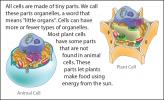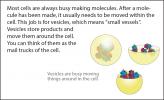
show/hide words to know
ATP: adenosine triphosphate. ATP is the energy-carrying molecule of all cells......more
Cell: a tiny building block that contains all the information necessary for the survival of any plant or animal. It is also the smallest unit of life... more
DNA (deoxyribonucleic acid): molecular instructions that guide how all living things develop and function...more
Lipid: a building block of life (molecule) made from smaller pieces (fatty acids). There are several kinds of lipids - fats, waxes, sterols,... more
Molecule: a chemical structure that has two or more atoms held together by a chemical bond. Water is a molecule of two hydrogen atoms and one oxygen atom (H2O)... more
Organelle: "little organ". An internal organ of a cell... more
Protein: a type of molecule found in the cells of living things, made up of special building blocks called amino acids.
Flashcard facts and information about the parts of the cell
Biology Bits stories are a great way for you to learn about biology a little bit at a time. We’ve broken down information into pieces that are very tiny—bite-sized biology cards. Cutting out the cards will let you organize them however you want, or use them as flashcards while you read.
This set of bits will teach you about the tiny world on which life depends: the parts inside a cell. To learn more about the science behind your cells, visit Building Blocks of Life - Parts of the Cell.
Play the slide show from the beginning or pick a slide to begin with by clicking on a slide below.
View Citation
Bibliographic details:
- Article: Cell Parts Bits
- Author(s): Karla Moeller
- Publisher: Arizona State University School of Life Sciences Ask A Biologist
- Site name: ASU - Ask A Biologist
- Date published: September 17, 2014
- Date accessed: January 11, 2025
- Link: https://askabiologist.asu.edu/biology-bits/cell-parts-bits
APA Style
Karla Moeller. (2014, September 17). Cell Parts Bits. ASU - Ask A Biologist. Retrieved January 11, 2025 from https://askabiologist.asu.edu/biology-bits/cell-parts-bits
Chicago Manual of Style
Karla Moeller. "Cell Parts Bits". ASU - Ask A Biologist. 17 September, 2014. https://askabiologist.asu.edu/biology-bits/cell-parts-bits
Karla Moeller. "Cell Parts Bits". ASU - Ask A Biologist. 17 Sep 2014. ASU - Ask A Biologist, Web. 11 Jan 2025. https://askabiologist.asu.edu/biology-bits/cell-parts-bits
MLA 2017 Style

Here are some pieces of biology that you can sink your teeth into. One bit at a time.
Be Part of
Ask A Biologist
By volunteering, or simply sending us feedback on the site. Scientists, teachers, writers, illustrators, and translators are all important to the program. If you are interested in helping with the website we have a Volunteers page to get the process started.

























![Deoxyribonucleic Acid – [de-ox-se-ri-bow-new-clay-ic] [as-id]; Endoplasmic reticulum – [end-uh-plaz-mik] [ri-tick-you-lum]; Adenosine triphosphate – [uh-den-oh-seen] [try-fos-fate]; Centriole – [sen-tree-ol]; Chloroplast – [klor-uh-plast]; Cytoplasm– [si-toe-pla-zem]; Cytoskeleton – [si-toe-skel-a-ton]; Golgi complex – [goal-gee] [com-plex]; Lysosome – [lie-suh-sohm]; Mitochondria – [mi-ta-kon-dree-a]; Peroxisome– [per-rocks-ee-sohm]; Ribosome – [ri-ba-sohm] Cartoon face talking](https://legacy.askabiologist.asu.edu/sites/default/files/styles/biology_bit_thumbnail_120x74/public/biology-bits-cell-parts-slide-19.jpg?itok=OAcozfOX)


 For Teachers
For Teachers